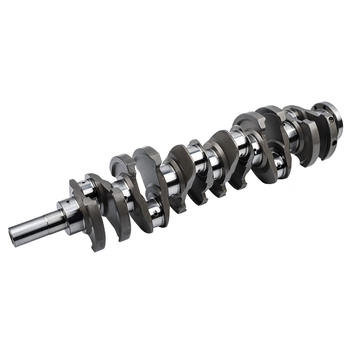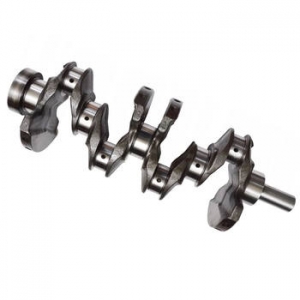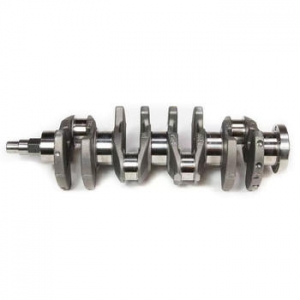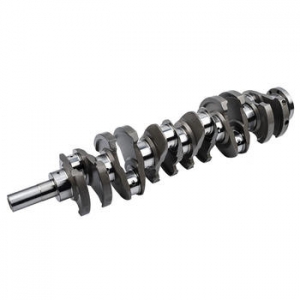The Heart of the Engine: How to Choose the Right Crankshaft Manufacturer
Have you ever stopped to think about the incredible forces a single engine component endures? Deep within the block, there's a component that is, frankly speaking, the backbone of your entire internal combustion engine. It's the crankshaft. This masterfully engineered piece of metal converts the linear motion of the pistons into the rotational force that ultimately turns your wheels. When it works, you don't think about it. But when it fails, the results are catastrophic. This is precisely why the selection of a world-class crankshaft manufacturer is not just a detail; it's the foundation of a reliable, powerful, and long-lasting engine build.
Whether you're restoring a classic car, building a high-horsepower race engine, or specifying components for heavy-duty industrial machinery, the company crafting your crankshaft holds your project's success in its hands. But with so many options out there, how do you separate the true artisans from the mass producers? This guide will walk you through everything you need to know.
What Truly Defines a Top-Tier Crankshaft Manufacturer?
It's easy to assume that making a crankshaft is a straightforward process. You get a chunk of metal, machine it into the right shape, and you're done, right? To be honest, that couldn't be further from the truth. The difference between a mediocre crankshaft and a superior one lies in a combination of science, art, and an obsessive commitment to quality. A leading manufacturer isn't just a factory; they are an engineering partner.
Engineering Expertise and R&D
The best manufacturers don't just follow a blueprint; they help create it. They employ teams of mechanical engineers who live and breathe engine dynamics. They use sophisticated tools like Finite Element Analysis (FEA) to digitally simulate the stresses a crankshaft will face under extreme loads, high RPMs, and intense vibrations. This allows them to optimize the design, strategically removing weight without sacrificing strength and engineering counterweights with surgical precision. This R&D investment is what separates a part that simply "fits" from a part that truly performs.
Quality Control and Certifications
Trust is everything in engine building. A premier crankshaft manufacturer builds that trust through rigorous, transparent quality control. It's worth noting what this actually involves:
- Material Traceability: They can tell you the exact origin and composition of the steel used for your specific crankshaft, backed by mill certificates.
- Rigorous Testing: Every single high-performance crankshaft should undergo a battery of non-destructive tests. This includes magnafluxing (magnetic particle inspection) to detect invisible surface cracks and ultrasonic testing to find internal flaws.
- Dimensional Accuracy: They use climate-controlled rooms and advanced CMM (Coordinate Measuring Machine) equipment to ensure every journal, pin, and fillet radius is machined to incredibly tight tolerances, often measured in the ten-thousandths of an inch.
- Certifications: Look for certifications like ISO 9001, which demonstrates a commitment to a globally recognized quality management system.
Customer Collaboration and Support
A truly great supplier acts as a consultant. They ask about your specific application, your horsepower goals, your intended RPM range, and the other components in your rotating assembly. They work with you to ensure the final product is a perfect match for your project. This collaborative approach, combined with responsive post-sale support, is the hallmark of a company that stands behind its work.

The Core of the Craft: Crankshaft Manufacturing Processes Explained
The method used to create the initial shape of a crankshaft has a profound impact on its final strength and performance characteristics. Understanding these core processes is crucial when evaluating a potential supplier and their capabilities. In my experience, the manufacturing method is one of the most significant cost and performance drivers.
Forging vs. Billet vs. Casting
These three terms are often thrown around, but they represent vastly different approaches to manufacturing.
- Forging: This is the champion of strength. In this process, a piece of steel is heated to a malleable temperature and then pounded or pressed into shape using immense force. This process forces the internal grain structure of the metal to align with the shape of the crankshaft, creating a continuous, unbroken flow. This grain flow makes a forged crankshaft exceptionally resistant to the twisting (torsional) and bending forces it will experience. The custom crankshaft forging process is the gold standard for most high-performance and heavy-duty applications.
- Billet: A billet crankshaft is machined from a solid, forged bar or "billet" of steel. There is no die-forging to get the rough shape; instead, a CNC machine meticulously carves the entire crankshaft from the block. This method offers incredible design flexibility and precision, making it ideal for one-off custom builds or small production runs where creating expensive forging dies isn't feasible. While very strong, some experts argue the grain structure isn't as optimally aligned as a true forging.
- Casting: This is the most common method for standard passenger car engines. Molten iron or steel is poured into a mold to create the basic crankshaft shape. It's a cost-effective process for mass production, but cast cranks lack the strength and fatigue resistance of their forged or billet counterparts. They are perfectly adequate for stock power levels but are not suitable for serious performance applications.
The Machining and Finishing Journey
Creating the initial shape is just the beginning. The magic happens in the subsequent steps, which require immense precision.
First, the raw forging or casting is rough-machined to get it closer to its final dimensions. Then comes one of the most critical steps: heat treatment. Processes like gas nitriding or induction hardening create an incredibly hard, wear-resistant surface on the bearing journals, which is essential for longevity. After heat treatment, the crankshaft undergoes a series of precision grinding operations to bring the main and rod journals to their exact final size with a mirror-smooth surface finish. Finally, the entire assembly is dynamically balanced to eliminate vibrations that could destroy engine bearings and rob power. The precision of this balancing act is a key differentiator for a high-end manufacturer.
Material Matters: A Deep Dive into High-Performance Crankshaft Materials
The material a crankshaft is made from is just as important as how it's made. The choice is a careful balance between tensile strength (resistance to being pulled apart), fatigue strength (durability over millions of cycles), and cost. A knowledgeable manufacturer will guide you to the right material for your specific needs.

Common High-Strength Steel Alloys
For most performance builds, you'll encounter a few key steel alloys. These materials offer a fantastic blend of strength and value.
- 4340 Steel: This is arguably the most popular material for aftermarket high-performance crankshafts in North America. It's a nickel-chromium-molybdenum alloy steel known for its excellent toughness, strength, and fatigue resistance. A well-designed 4340 forged crank can reliably handle well over 1,000 horsepower in many applications.
- EN40B Steel: This is a chromium-molybdenum steel that is very popular in Europe and is renowned for its suitability for the nitriding process. It can be heat-treated to achieve an extremely hard and durable surface, making it an excellent choice for endurance racing and high-load applications.
Frankly speaking, for 95% of performance engine builds, a properly manufactured crankshaft from one of these materials will be more than sufficient. The key is the quality of the raw material and the manufacturing process itself.
Advanced and Exotic Materials
When you push into the realm of elite motorsport or extreme power builds (think 2,500+ horsepower), you start to see more exotic materials. The choice of high-performance crankshaft materials becomes paramount. Alloys like 300M, a modified 4340 with added silicon and vanadium, offer even higher tensile strength and are used where every ounce of strength is needed. The cost increases significantly, but for those pushing the absolute limits of performance, it's a necessary investment.
How to Choose the Right Crankshaft Supplier for Your Needs
Now that you're armed with the technical knowledge, how do you actually select the right partner? This is where you combine what you know with smart vetting. Following a clear process for choosing the right crankshaft supplier will save you time, money, and potential engine-related heartache down the road.
Define Your Application Clearly
Before you even make a phone call, be clear about your needs. Are you building a 400-horsepower street engine that needs to be reliable for 100,000 miles? Or are you building a 1,500-horsepower drag race engine that will be torn down after every weekend? The material, design, and cost for these two applications are worlds apart. Having this information ready will make your conversation with a potential supplier far more productive.
Ask the Right Questions
Don't be afraid to interview a potential manufacturer. Their answers will reveal a lot about their processes and their philosophy. Here are some great questions to start with:
- What is your typical lead time for a custom or semi-custom crankshaft?
- Can you provide material certification documents for the steel you use?
- What specific non-destructive testing methods do you perform on every performance crankshaft?
- What are your balancing tolerances, and do you provide a balance sheet?
- Can you share examples or case studies of your work with engines similar to mine?
Look for Evidence and Reputation
In my experience, the best companies are proud of their work and have a strong reputation in the industry. Look for testimonials from respected engine builders. See if they are the chosen supplier for any professional race teams. A strong presence in the performance community is often a good sign that they deliver on their promises. A cheap, no-name crankshaft might save you a few hundred dollars upfront, but the potential cost of an engine failure makes it a risk that's simply not worth taking.
Ultimately, selecting a crankshaft manufacturer is about choosing a partner in performance. It's an investment in the very heart of your engine. By focusing on engineering expertise, robust quality control, superior materials, and a collaborative spirit, you can ensure that the foundation of your build is strong enough to handle whatever power you decide to throw at it.
For more detailed information, please visit our official website:crankshaft manufacturer
About the author: Marcus Thorne is a seasoned mechanical engineer with over 20 years of experience in high-performance engine design and component manufacturing. Having worked with top-tier motorsport teams and specialty engine builders, he has a deep understanding of the material science and precision engineering required to build powerful and reliable engines. He enjoys sharing his insights to help enthusiasts and professionals make more informed decisions about critical engine components. ---
 The Heart of Horsepower: How t
The Heart of Horsepower: How t
 The Heart of Your Engine: Your
The Heart of Your Engine: Your
 The Heart of the Engine: How t
The Heart of the Engine: How t
 The Unseen Powerhouse: Unveili
The Unseen Powerhouse: Unveili
